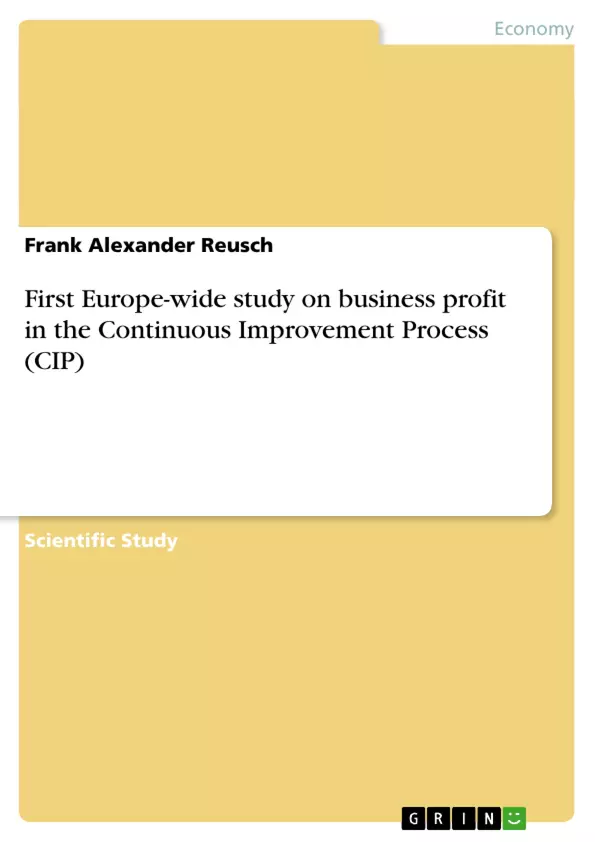7,000 executives in the five largest European economies Germany, United Kingdom, France, Italy and Spain was asked about the business profit in the Continuous Improvement Process (CIP). There was the perception, likewise in the wake of the financial crisis, that organic growth strategies are gaining traction. This is of interest because efficient CIP is a crucial success factor in organic growth.
For this reason, the aim of this Europe-wide study is to find out:
- whether CIP is viewed by executives as a sensible long-term basis for profitable growth,
- the present status of CIP implementation in the chief European economies,
- what experience companies have gained with CIP,
- whether investment in CIP is paying off, and
- in which areas CIP can be usefully applied.
An absolute majority of the respondents (62,8 %)spoke out in favour of CIP as a target-oriented tool.
In this study, the dominant corporate strategy was chosen as a basis for differentiated statements. In fact, 69 % of the executives assess the importance of organic growth strategies as high or very high. By contrast, the significance of company acquisitions was rated high or very high by 42 %.
This study can deliver an initial indication of the level of penetration in companies that is needed for CIP to generate the greatest possible benefit.
The study has furnished evidence that an appreciable number of companies apply CIP and obtain considerable benefit from doing so. CIP offers an outstanding opportunity for further developing core competencies and improving performance in an entire company - unnoticed by competitors - and for sustainably defending such advances. The object of optimization is a whole enterprise - let the best show the way.
Inhaltsverzeichnis (Table of Contents)
- Foreword
- Executive summary
- Introduction
- Objectives of the study
- Study method
- Participation
- Basic data of the participating companies
- Number of employees
- Sector membership
- Legal forms
- Corporate strategy and market assessment
- Results of the CIP clusters
- Implementation
- Degree of implementation in companies
- Current scope of CIP as applied
- Organization
- Responsibility for CIP
- Efficacy of CIP organization
- Methods
- Systematics of the methods employed
- CIP methods
- Culture of change, willingness to embrace change
- Role of information technology
- Including customers and suppliers in CIP
- Results
- CIP results
- Penetration in companies
- Measurability and transparency of the CIP results
- General acceptance in companies
- CIP deployment areas
- Matching market situations with CIP options
- The basis: willingness to embrace change, culture of change
- CIP An overall assessment
Zielsetzung und Themenschwerpunkte (Objectives and Key Themes)
This study aims to provide a comprehensive overview of the current state of Continuous Improvement (CIP) within European businesses. It investigates the extent to which CIP is implemented, its organizational structures, methods used, and the resulting outcomes. The study also examines the factors that influence the success of CIP, including the corporate culture and market conditions.
- Implementation and Scope of CIP in European Businesses
- Organizational Structures and Responsibility for CIP
- Methods Employed in CIP and their Effectiveness
- Impact of Culture and Market Conditions on CIP Success
- Assessment of CIP Results and Overall Performance
Zusammenfassung der Kapitel (Chapter Summaries)
The Foreword discusses the challenges and misconceptions surrounding CIP in today's business world, highlighting the need for a management-geared approach. It emphasizes the importance of integrating CIP into core business processes, emphasizing the role of executives in driving continuous improvement initiatives.
The Introduction outlines the study's objectives, methodology, and the characteristics of the participating companies. It provides essential information on the sample size, industry sectors represented, legal forms, and corporate strategies of the companies involved.
The Results of the CIP clusters section delves into the various aspects of CIP implementation, organization, methods used, and results achieved within the participating companies. This section analyzes the degree of CIP implementation, the current scope of its application, the organizational structures responsible for CIP, and the effectiveness of these structures. It also examines the systematic approach to method selection, the specific CIP methods employed, the impact of organizational culture, the role of information technology, and the inclusion of customers and suppliers in CIP initiatives.
The chapter concludes with a detailed analysis of the results of CIP implementation, encompassing the penetration of CIP within companies, the measurability and transparency of results, general acceptance by employees, and the identification of key deployment areas. It also explores the relationship between market situations and CIP options, the influence of organizational culture, and provides a comprehensive overall assessment of CIP performance across the participating companies.
Schlüsselwörter (Keywords)
Continuous Improvement (CIP), European Businesses, Implementation, Organizational Structures, Methods, Culture of Change, Market Conditions, Results, Performance, Management-Geared Approach, Business Profit, Optimization, Corporate Strategy, Industry Sectors.
- Implementation
- Citation du texte
- Diplom-Betriebswirt (FH) Frank Alexander Reusch (Auteur), 2009, First Europe-wide study on business profit in the Continuous Improvement Process (CIP), Munich, GRIN Verlag, https://www.grin.com/document/138376



